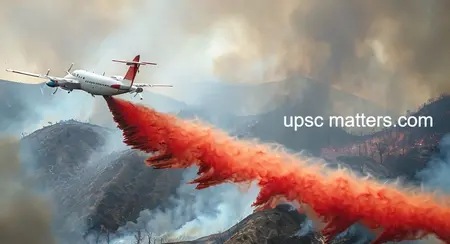Pink fire retardants are a critical tool in combating wildfires, especially in large-scale operations. Their distinctive pink color (achieved with fugitive dyes) helps pilots and ground crews track application areas.
Context- Pink fire retardants are currently in the news due to several global and India-specific factors, like Wildfire incidents (California forestfire)
UPSC Relevance
GS III (Disaster Management): NDMA’s strategies, FAST India, and NAPFF 2018.
GS III (Environment): Retardant chemicals’ ecological impact vs. wildfire mitigation.
GS III (Science & Tech): Chemistry of fire retardants, Innovations in firefighting tech (drones, GIS).
Essay/ Ethics: Themes like “Development vs. Ecology” or “Technology in Disaster Management” can use pink retardants as an example.
Case Studies: Uttarakhand wildfires, Bandipur Reserve fires, global examples (Canada/Australia).
Unleashing the Power of Pink: The Science Behind Pink Fire Retardants
Active Ingredients:
- Ammonium Phosphate/Sulfate: Primary fire-inhibiting agents. They release water when heated, cool fuels, and coat vegetation to block combustion.
- Corrosion Inhibitors: Protect aircraft and equipment from chemical damage.
- Thickeners (e.g., guar gum): Ensure the retardant adheres to vegetation.
- Pink Dye: Non-toxic, temporary dye (e.g., rhodamine B) for visibility. Fades with sunlight exposure.
Function:
- Create firebreaks by slowing flame spread.
- Protect vulnerable areas (e.g., communities, infrastructure).
Application Methods
- Aerial Delivery: Airplanes/helitankers drop retardant in advance of wildfires to create containment lines. Used in inaccessible terrain (e.g., forests, mountains).
- Ground Application: Firefighters use pumps/hoses for spot treatments near assets
The Hidden Cost of Pink: Environmental Risks and Debates
Ecological Impact:
- Generally safe but regulated to avoid water contamination (e.g., ammonia harms aquatic life).
- High phosphorus content may cause algal blooms in water bodies.
- Soil impact: Temporary pH changes but minimal long-term harm.
Regulations:
- EPA Guidelines (U.S.): Mandate buffer zones near waterways.
- India: Follows similar protocols under the Environmental Protection Act, 1986.
Effectiveness & Limitations of Pink Fire Retardants
Pros:
- Buys time for ground crews to contain fires.
- Reduces fire intensity, protecting ecosystems and human settlements.
Cons:
- Weather-dependent (rain can wash it off).
- Not a fire extinguisher; works best with other strategies (e.g., backburning).
Innovations & Alternatives to Pink Fire Retardants
Eco-Friendly Formulations: Reduced ammonia content and biodegradable additives. Colored alternatives (e.g., orange) for specific terrains.
Gel-Based Retardants: Longer adhesion to vegetation.
India’s Wildfire Vulnerability
- Himalayan States (Uttarakhand, Himachal Pradesh):Dry winters, pine forests (resin-rich), and human activities (e.g., slash-and-burn agriculture) trigger fires.Example: 2021 Uttarakhand wildfires destroyed 1,500+ hectares.
- Western Ghats: Biodiversity hotspots face fires during summer due to leaf litter accumulation and encroachment.
- Climate Change Link: Rising temperatures and erratic rainfall exacerbate fire risks.
India’s Wildfire Battle Plan: NDMA, FAST India, and the 2018 Action Plan
National Disaster Management Authority (NDMA)
- Role: Apex body for disaster management in India. Formulates policies (e.g., National Disaster Management Plan, 2016) and coordinates wildfire response.
- Initiatives: Promotes community preparedness, early warning systems, and inter-agency collaboration (NDRF, Forest Departments).
National Action Plan on Forest Fires (NAPFF), 2018
- Objectives: Prevention: Awareness campaigns, regulated burning.
- Preparedness: Fire lines, watchtowers, and community training.
- Response: Strengthened coordination between forest departments and NDMA.
- Capacity Building: Modern equipment (drones, GIS) for real-time monitoring.
FAST India Initiative
- Full Form: Forest Fire Alert System for Timely Response.
- Purpose: Rapid detection and response using:
- Satellite Alerts: ISRO’s SNPP-VIIRS sensors for real-time fire alerts.
- Mobile Apps: e.g., Van Agni Geo Portal for ground staff.
- Impact: Reduced response time from hours to minutes in critical zones.
Key Concepts for Wildfire Management in India
Fugitive Dye
- Definition: A temporary, non-toxic dye (e.g., rhodamine B) added to fire retardants for visibility.
- Purpose: Helps pilots track application areas during aerial drops. Fades with sunlight to minimize environmental impact.
Ammonium Phosphate
- Role: Primary chemical in fire retardants. Releases water when heated, cooling flames and forming a protective barrier on vegetation.
- Concerns: Risk of water contamination (e.g., algal blooms) if washed into water bodies. Regulated under EPA/India’s environmental guidelines.
Firebreak
- Definition: A gap in vegetation (natural or human-made) to halt wildfire spread.
- Methods: Cleared land, rivers, or roads. Critical in protecting communities and forests.
Rhodamine B
Use: Pink dye in retardants. Non-toxic but debated for potential ecological effects. Regulated to ensure minimal harm.
Key Takeaway
While California’s fires have amplified global discourse, India’s own wildfire crises and policy reforms make this topic UPSC-relevant. Aspirants should focus on:
- How global examples (e.g., U.S., Australia) inform India’s approach.
- Balancing firefighting efficacy with environmental safeguards.
- The role of technology (drones, GIS) in improving retardant targeting.
California’s fires are a contextual example, but India’s challenges and solutions should remain the core focus for exams. 🌍🔥
If you found this helpful, you might also like these articles:
📌 [ https://upscmatters.com/euclid-space-telescope-unveils-a-einstein-ring/]
📌 [https://upscmatters.com/fourth-form-of-water-ez-water-discovery/ ]
They cover key concepts that will boost your preparation! 🚀
📢 Stay Updated with the Best UPSC Resources!
Join our Telegram Channel for:
✅ Daily Current Affairs
✅ Important Notes & PDFs
✅ Answer Writing Tips
✅ Strategy & Motivation
📲 Click the link to join now: [https://t.me/upscmatters] or [https://t.me/ramsirnotes]
Don’t miss out on valuable updates! 🚀


7 thoughts on “Pink Fire Retardants in Wildfire Management: Environmental Impact, Policy Insights & Relevance for UPSC Aspirants”